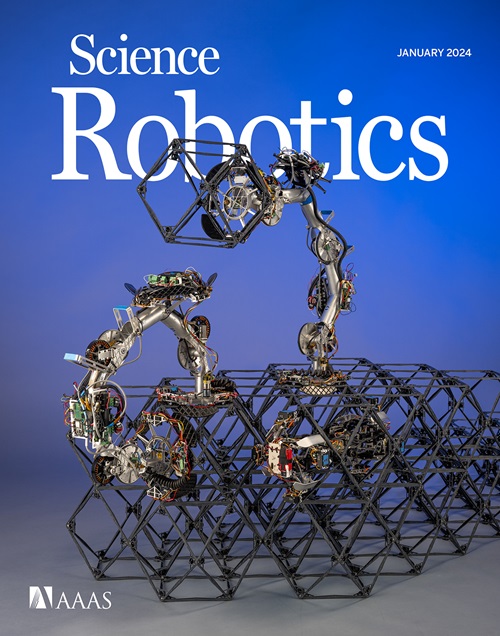通过手外骨骼的新颖感官体验,超越了运动专业知识的天花板效应
IF 26.1
1区 计算机科学
Q1 ROBOTICS
引用次数: 0
摘要
对于训练有素的个人,如运动员和音乐家,学习往往在大量训练后停滞不前,被称为“天花板效应”。要克服的一个瓶颈是没有要学习的技能的先验物理经验。在这里,我们通过使用可以快速独立移动单个手指的手外骨骼机器人,将专家钢琴家暴露在无法自主执行的快速复杂的手指运动中来挑战这个问题。尽管经过数周的钢琴练习,手指的移动技能很快就达到了平台状态,但被动地接触外骨骼机器人以比钢琴家最快的速度更快的速度产生的复杂手指动作,使他们弹得更快。无论是快速但简单的手指运动训练,还是缓慢但复杂的外骨骼运动训练,都不能提高过度训练的运动技能。单手外骨骼训练也提高了未训练的对侧手的运动技能,显示了手间转移效应。训练改变了钢琴演奏过程中多个手指肌肉的协调活动模式,但对一般运动和体感功能或手的解剖特征(运动范围)没有影响。通过被动暴露于快速和复杂的手指运动中,经颅磁刺激引起的左运动皮层多指运动模式也发生了变化,这伴随着个性化手指运动特征的组成运动元素的参与增加。结果表明,体感暴露于没有经验的运动技能中,可以以特定任务但独立于效应者的方式克服天花板效应。本文章由计算机程序翻译,如有差异,请以英文原文为准。

Surmounting the ceiling effect of motor expertise by novel sensory experience with a hand exoskeleton
For trained individuals such as athletes and musicians, learning often plateaus after extensive training, known as the “ceiling effect.” One bottleneck to overcome it is having no prior physical experience with the skill to be learned. Here, we challenge this issue by exposing expert pianists to fast and complex finger movements that cannot be performed voluntarily, using a hand exoskeleton robot that can move individual fingers quickly and independently. Although the skill of moving the fingers quickly plateaued through weeks of piano practice, passive exposure to otherwise impossible complex finger movements generated by the exoskeleton robot at a speed faster than the pianists’ fastest one enabled them to play faster. Neither a training for fast but simple finger movements nor one for slow but complex movements with the exoskeleton enhanced the overtrained motor skill. The exoskeleton training with one hand also improved the motor skill of the untrained contralateral hand, demonstrating the intermanual transfer effect. The training altered patterns of coordinated activities across multiple finger muscles during piano playing but not in general motor and somatosensory functions or in anatomical characteristics of the hand (range of motion). Patterns of the multifinger movements evoked by transcranial magnetic stimulation over the left motor cortex were also changed through passive exposure to fast and complex finger movements, which accompanied increased involvement of constituent movement elements characterizing the individuated finger movements. The results demonstrate evidence that somatosensory exposure to an unexperienced motor skill allows surmounting of the ceiling effect in a task-specific but effector-independent manner.
求助全文
通过发布文献求助,成功后即可免费获取论文全文。
去求助
来源期刊

Science Robotics
Mathematics-Control and Optimization
CiteScore
30.60
自引率
2.80%
发文量
83
期刊介绍:
Science Robotics publishes original, peer-reviewed, science- or engineering-based research articles that advance the field of robotics. The journal also features editor-commissioned Reviews. An international team of academic editors holds Science Robotics articles to the same high-quality standard that is the hallmark of the Science family of journals.
Sub-topics include: actuators, advanced materials, artificial Intelligence, autonomous vehicles, bio-inspired design, exoskeletons, fabrication, field robotics, human-robot interaction, humanoids, industrial robotics, kinematics, machine learning, material science, medical technology, motion planning and control, micro- and nano-robotics, multi-robot control, sensors, service robotics, social and ethical issues, soft robotics, and space, planetary and undersea exploration.
 求助内容:
求助内容: 应助结果提醒方式:
应助结果提醒方式:


